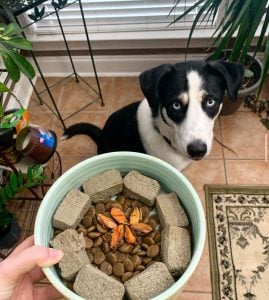That moment when your furry best friend, who once enthusiastically gobbled down every meal, suddenly starts sniffing their bowl with a look of utter disdain can be disheartening. You might think, “Are they sick? Is something wrong with the food?” While those are valid concerns to rule out with your vet, sometimes the culprit is simply… boredom. Yes, our intelligent companions can get tired of the same old kibble day in and day out!
But don’t despair, fellow pet parents! Just like us, dogs crave a little variety and excitement. Here are some tried-and-true tips and tricks to reignite your dog’s passion for mealtime and conquer that dreaded food boredom:

1. Rule Out Medical Issues First:
Before you start experimenting with new feeding strategies, it’s crucial to ensure there isn’t an underlying health problem causing your dog’s loss of appetite. A visit to your veterinarian is always the first step to rule out dental issues, digestive upset, or other medical conditions.
2. Introduce Variety (Gradually!):
Think about eating the same thing for every single meal. It wouldn’t be very exciting, would it? The same goes for your dog.
- Rotate Kibble Flavors or Proteins: If your dog does well on a particular brand, try switching between different protein sources (chicken, beef, lamb, fish) within that line. This offers a new taste and smell without drastic dietary changes. Remember to transition gradually over 5-7 days to avoid digestive upset by mixing increasing amounts of the new food with decreasing amounts of the old.
- Consider Wet Food Mix-Ins: A spoonful of high-quality wet food mixed with their kibble can add moisture, aroma, and a different texture that can be incredibly appealing. Again, introduce new wet food gradually.
3. Elevate the Eating Experience:
Sometimes, it’s not just what they’re eating, but how they’re eating it.
- Puzzle Feeders and Slow Feed Bowls: These interactive tools turn mealtime into a stimulating game. They encourage your dog to work for their food, slowing down eating and providing mental enrichment.
- Scatter Feeding: If your dog doesn’t have a strong prey drive that leads to resource guarding, try scattering their kibble in a safe, clean area of your yard or house. This engages their natural foraging instincts.
- Hand Feeding: Occasionally hand-feeding your dog their kibble can create a positive association with mealtime and strengthen your bond. This is especially helpful for picky eaters.

4. Enhance the Flavor Naturally:
You don’t need to resort to unhealthy additives to make their food more enticing.
- Warm Water or Low-Sodium Broth: A splash of warm water or low-sodium chicken or beef broth can enhance the aroma and make the kibble more palatable. Ensure the broth is onion and garlic-free, as these are toxic to dogs.
- Toppers (in moderation): Small amounts of dog-safe fruits (like blueberries or cooked sweet potato), vegetables (like cooked carrots or green beans), or plain cooked lean meats (like chicken or turkey) can be used as occasional toppers to add flavor and nutrients. Remember, these should only be a small percentage of their daily intake.
5. Be Consistent and Patient:
- Establish a Routine: Feed your dog at the same times each day. This helps regulate their appetite.
- Limited Time Offer: If your dog doesn’t eat their food within a reasonable timeframe (15-20 minutes), pick it up and offer it again at the next scheduled mealtime. Avoid leaving food out all day, as this can contribute to pickiness.
- Avoid Giving Too Many Treats: While treats are great for training, overdoing it can decrease your dog’s appetite for their regular food.
The Takeaway:
Dealing with a dog who’s suddenly gone off their food can be frustrating, but remember that food boredom is a real thing. By implementing these tips and observing your dog’s preferences, you can often reignite their enthusiasm for mealtime and ensure they’re getting the nutrition they need. And as always, when in doubt, consult with your veterinarian to rule out any underlying health concerns. Happy feeding!








